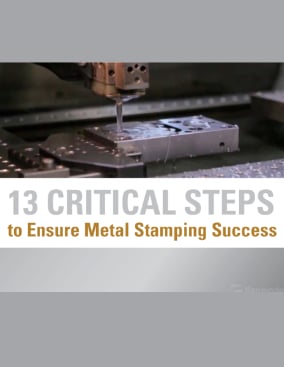What is Progressive Die Stamping?
A Comprehensive Guide
Progressive Die Stamping Overview
Progressive die stamping is a cornerstone of modern metal manufacturing, enabling the high-volume production of complex, precision metal components with remarkable speed and consistency. Widely used across industries such as automotive, electronics, aerospace, and consumer goods, this process combines multiple forming operations into a single, continuous cycle. This guide explores the fundamentals of progressive die stamping, how it works, its benefits and limitations, key applications, and best practices for implementation.
What Is Progressive Die Stamping?
Progressive die stamping is a metal forming process in which a strip of metal—typically fed from a coil—is incrementally shaped into a finished part through a series of stations within a single die set. Each station performs a specific operation (e.g., punching, bending, coining, or blanking), and the metal strip advances with each press stroke until the final station separates the completed part from the carrier strip.
Unlike other stamping methods, progressive dies allow multiple operations to occur in sequence without removing the workpiece, making the process highly efficient for mass production.
L E A R N M O R E
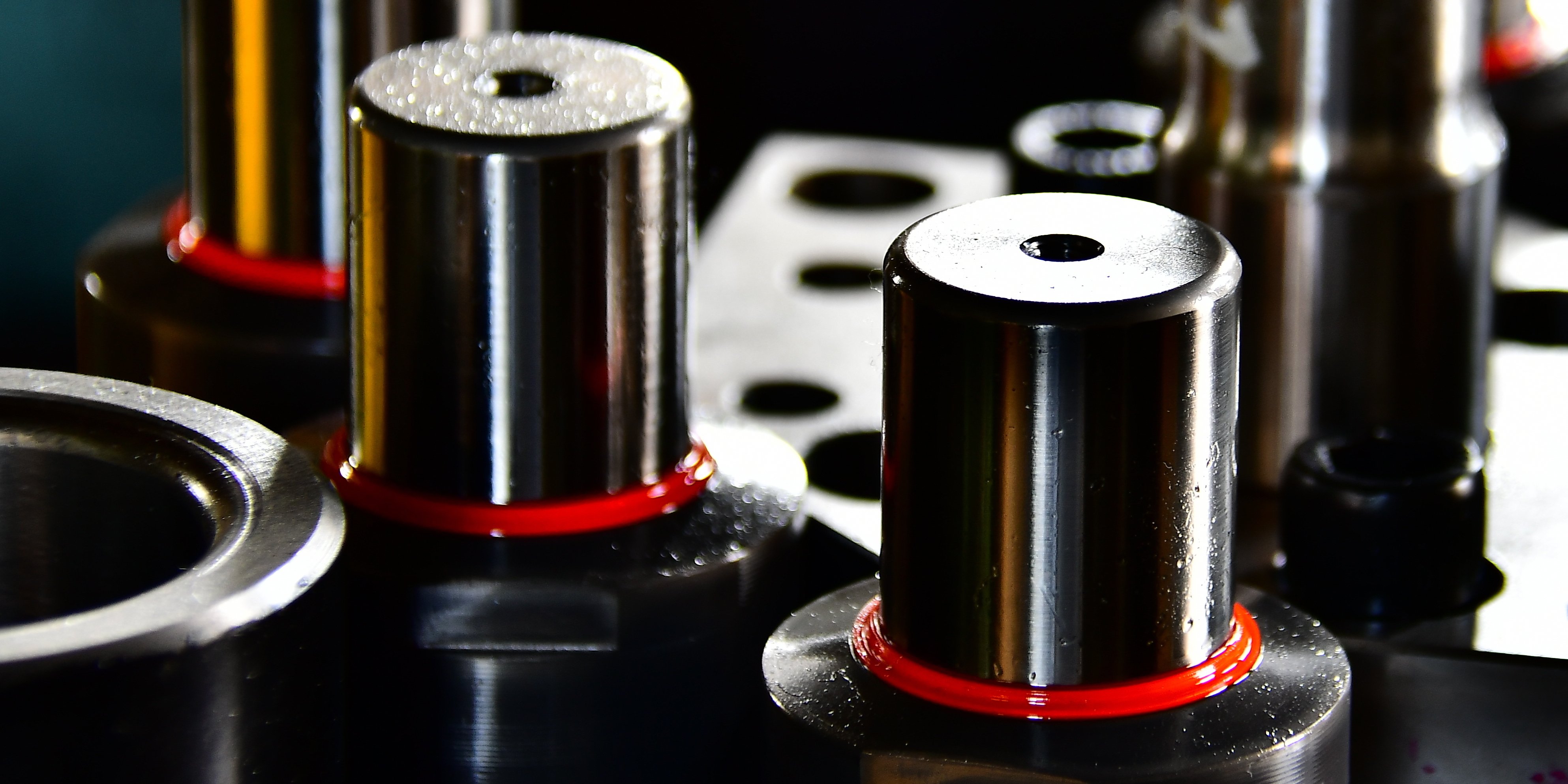
Progressive Stamping Delivers High Speed Production and Lower Costs
Progressive die stamping is a high-volume, high-performance metal stamping process that uses progressive dies, which perform multiple operations in ...
How Progressive Die Stamping Works
The process involves several key stages and components that work together seamlessly.
Material Feeding
- A coil of sheet metal (commonly steel, aluminum, brass, copper, or stainless steel) is loaded into an automated feeder.
- The feeder pulls the metal strip into the stamping press at precise intervals.
- The strip moves through the die in small, controlled increments—typically synchronized with the press stroke.
Die Stations
- The progressive die contains multiple stations, each designed to perform a specific operation.
- As the press cycles, the metal strip advances one step forward, and each station performs its designated task.
- Operations may include:
- Piercing: Creating holes or cutouts.
- Punching: Removing material to form shapes.
- Bending: Folding the metal into desired angles.
- Coining: Applying high pressure to create fine details or embossing.
- Blanking: Cutting out the final part shape.
Carrier Strip and Web Design
- The part remains attached to a carrier strip (also called a "web") throughout the process.
- This ensures stability and accurate positioning as it moves through each station.
- In the final station, the finished part is sheared or broken free from the carrier strip.
Precision Alignment
- Conical pilots or guide pins ensure precise alignment between the strip and each die station.
- Tolerances can be maintained within ±0.001 inches (0.025 mm), ensuring consistency across thousands or millions of parts.
Ejection and Collection
- Completed parts are ejected automatically and collected for further processing or packaging.
- The leftover carrier strip is typically wound up or cut for recycling.
- In reel-to-reel stamping, the metal strip is advanced through a series of progressive operations and is typically re-rolled for subsequent processing like plating or assembly.
Key Components of a Progressive Die
A progressive die is a complex assembly made from hardened tool steel. Its main components include:
- Die Set: The upper and lower plates that house all tooling elements and align with the press.
- Punches and Dies: Tools that cut, form, or shape the metal at each station.
- Strippers: Hold the metal strip in place during punching to prevent deformation.
- Guides and Pilots: Ensure accurate positioning of the strip as it advances.
- Springs and Ejectors: Help remove formed parts and maintain strip tension.
- Fasteners and Bushings: Secure components and allow smooth movement.
These components are machined using advanced techniques such as CNC milling, grinding, and wire electrical discharge machining (EDM) to achieve high precision and durability.
Advantages of Progressive Die Stamping
Progressive die stamping offers numerous benefits, especially for high-volume manufacturing:
High Production Speed
- Parts are produced with every press stroke—often hundreds or thousands per minute.
- Ideal for large production runs where speed and throughput are critical.
Cost Efficiency
- Reduces labor and handling costs by combining multiple operations into one process.
- Minimizes the need for secondary operations and additional equipment.
- Studies show progressive die stamping requires 38% less setup time compared to multi-slide methods.
Consistent Quality and Precision
- Tight tolerances are maintained due to fixed tooling and automated feeding.
- Repeatability ensures uniformity across large batches.
Material Efficiency
- Optimized strip layouts minimize scrap.
- Leftover carrier strips can be recycled, reducing material waste.
- Techniques like nesting and coining further improve yield.
Automation-Friendly
- Easily integrated with robotic feeders, vision systems, and quality inspection tools.
- Supports lights-out manufacturing for 24/7 operation.
L E A R N M O R E

The Advantages and Disadvantages of Running Metal Stamping Family Dies
Family tooling is a method in which a manufacturer designs and builds a die that is able to simultaneously produce multiple components in different ...
Limitations and Challenges
While powerful, progressive die stamping is not suitable for every application:
High Initial Tooling Costs
- Designing and manufacturing a progressive die can be expensive, often costing tens of thousands of dollars depending on complexity.
- This makes the process most economical for high-volume production runs (typically tens of thousands to millions of parts), where the per-unit cost savings offset the initial investment.
- Low-volume or prototype projects may find other methods—like laser cutting or turret punching—more cost-effective.
Long Lead Times for Die Development
- Designing, machining, assembling, and testing a progressive die can take several weeks to months.
- Any design changes after the die is built may require costly modifications or even a complete rebuild.
- Requires close collaboration between design engineers and toolmakers to ensure accuracy from the start.
Limited Flexibility
- Once a die is built, it is dedicated to a specific part design.
- Minor design changes (e.g., hole size, bend angle) may require tooling adjustments, while major changes often necessitate a new die or expensive die modifications.
- Not ideal for products with frequent design iterations.
Complexity in Design and Maintenance
- Designing a progressive die requires expertise in metal forming, strip layout, and material behavior.
- Issues such as stretch-web deformation, misalignment, or tool wear can affect part quality.
- Dies require regular maintenance, lubrication, and inspection to ensure longevity and consistent output.
L E A R N M O R E

The Advantages and Disadvantages of Running Metal Stamping Family Dies
Family tooling is a method in which a manufacturer designs and builds a die that is able to simultaneously produce multiple components in different ...
Common Applications Across Industries
Progressive die stamping is used to manufacture a wide range of precision metal components. Key industries include:
Automotive
- Structural brackets, clips, sensors, electrical connectors, seat components, busbars, and engine parts.
- Enables high-speed production of safety-critical components with tight tolerances.
Electronics and Electrical
- Terminals, connectors, shielding, relay parts, and heat sinks.
- Ideal for small, intricate parts made from conductive materials like copper and brass.
Aerospace
- Lightweight brackets, fasteners, connectors, and control system components.
- Used for high-strength alloys requiring precision and reliability.
Medical Devices
- Surgical instrument components, implantable device housings, and diagnostic equipment parts.
- Supports strict quality standards and biocompatible materials like stainless steel.
Appliances and Consumer Goods
- Hinges, latches, motor components, and decorative metal trims.
- Delivers consistent finishes and functional performance at scale.
Design Considerations for Progressive Die Stamping
To ensure success, part and die design must account for several critical factors:
Part Geometry and Complexity
- Avoid overly complex shapes that require deep draws or multiple directions of forming.
- Design bends with appropriate radii to prevent cracking.
- Minimize sharp corners and thin sections that can weaken the part or die.
Material Selection
- Choose materials based on strength, formability, corrosion resistance, and cost.
- Common choices:
- Mild steel – cost-effective and easy to form.
- Stainless steel – durable and corrosion-resistant.
- Aluminum – lightweight but less formable.
- Copper and brass – excellent for electrical conductivity.
Strip Layout (Progression Design)
- The arrangement of parts along the strip affects material utilization and die size.
- Use nesting software to optimize spacing and minimize scrap.
- Include sufficient web width to maintain strip strength during feeding.
Tolerances and Surface Finish
- Specify realistic tolerances—tighter specs increase cost and complexity.
- Consider secondary operations (e.g., plating, deburring) and other specialty coatings if needed for finish or function.
Pilot Holes and Alignment Features
- Incorporate pilot holes or guide features to ensure accurate strip positioning.
- Use conical pilots for high-precision alignment between stations.
L E A R N M O R E
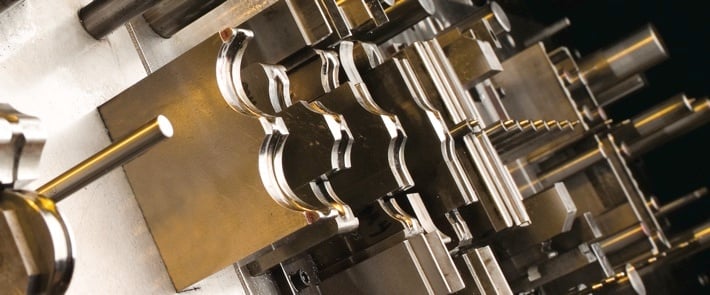
Using Multiple-Up Dies for Metal Stamping to Save Money and Boost Volume
Designing the metal stamping die to produce a new precision part is one of the most important steps to ensuring long-term success in production. ...
Best Practices for Successful Implementation
To maximize efficiency and quality in progressive die stamping, follow these industry best practices:
- Collaborate Early: Involve manufacturing engineers during the design phase (Design for Manufacturing – DFM) to identify potential issues early.
- Use Simulation Software: Leverage metal forming simulation tools (e.g., DynaForm, Stamppack, PAM-STAMP) to predict material flow, stress points, and potential defects.
- Invest in Quality Tooling: High-grade tool steel and precision machining extend die life and reduce downtime.
- Implement Preventive Maintenance: Regular cleaning, lubrication, and inspection prevent unexpected failures.
- Monitor Production in Real Time: Use sensors and vision systems to detect misfeeds, missing features, or tool wear.
- Optimize Feed Length and Press Speed: Balance cycle time with material handling capabilities to avoid jams or inaccuracies.
Progressive Die vs. Other Stamping Methods
Progressive die, transfer, deep drawing, and single-stage stamping are distinct metal forming processes suited to different production needs based on volume, complexity, and part geometry. Progressive and transfer die stamping are ideal for high-volume or complex parts, while single-stage is better for low-volume runs, and deep drawing specializes in producing deep, cup-shaped components.
Below is a comparison of the four stamping methods:
Progressive Die Stamping
- Involves feeding a metal strip through multiple stations where each station performs a different operation (e.g., punching, bending, forming) until the final part is completed, with the finished part separated at the last stage.
- Best suited for high-volume production of small to medium-sized parts with tight tolerances and complex geometries.
- Advantages include high speed, low labor costs, minimal scrap, and the ability to combine multiple operations in one continuous process.
- Limitations include high initial tooling costs and unsuitability for deep-draw applications due to the strip remaining attached during processing.
Transfer Die Stamping
- Begins with cutting the blank from the metal strip, after which the individual part is mechanically transferred between stations for sequential operations
- Ideal for large, complex, or deep-drawn parts such as automotive frames, shells, and structural components.
- Offers greater flexibility in part handling and orientation, enabling intricate features like ribs, knurls, and threading.
- Typically has higher operational and setup costs compared to progressive stamping but allows deeper drawing since the part is free from the carrier strip.
Deep Drawing
- A specialized forming process where a flat metal blank is radially drawn into a die to form a deep, hollow part, often in multiple stages with annealing in between.
- Commonly used for cylindrical or box-shaped components like cups, cans, and enclosures requiring significant depth relative to diameter.
- Transfer die stamping is typically preferred for deep-draw operations because the detached blank allows unrestricted punch travel.
- Not feasible with standard progressive dies due to material strip constraints.
Single-Stage (or Simple Die) Stamping
- Performs only one operation (e.g., blanking or punching) per press stroke and is typically used for simpler parts.
- Suitable for low-volume production due to simple tooling, low cost, short lead time, and ease of adjustment.
- Less efficient for complex or high-volume parts but advantageous for prototyping or large parts where transfer between processes is cumbersome.
- Often used when batch size is small or when operational simplicity and safety are priorities
L E A R N M O R E
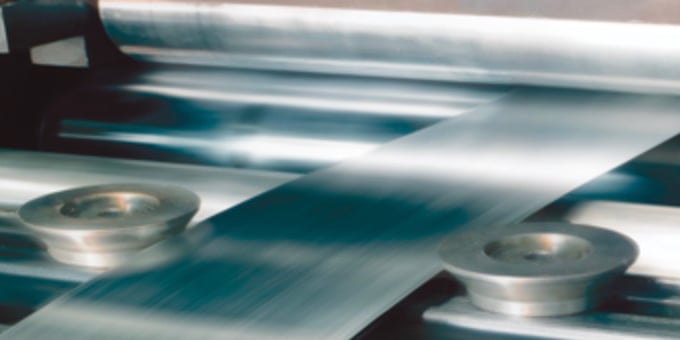
Progressive Die Stamping vs Transfer Die Stamping
If you’re responsible for designing or buying precision metal stamped parts, it’s important to understand when to use progressive die stamping versus ...
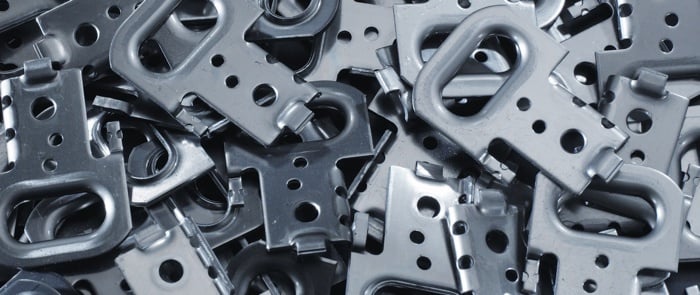
Progressive Stamping vs. Fine Blanking: Three questions OEMs Should Ask
For manufacturers who require precision parts with tight tolerances, it can pay to compare the options for manufacturing processes. Although fine ...
Table of Contents
- Progressive Die Stamping Overview
- How Progressive Die Stamping Works
- Key Components of a Progressive Die
- Advantages of Progressive Die Stamping
- Limitations and Challenges
- Common Applications Across Industries
- Design Considerations for Progressive Die Stamping
- Best Practices for Successful Implementation
- Progressive Die vs. Other Stamping Methods
Algonquin, IL 60102-2486
about
Get answers to your questions
Browse our Custom Metal Stamping Guide
Industries
- Privacy Policy
- Terms & Conditions
- Certifications (ITAR, ISO 9001, ISO 13485, ISO 14001, IATF 16949)



